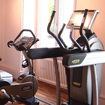Teaching Practice 2 - for TP 2b
B2 level
Description
Materials
Main Aims
-
To provide clarification and practice of new vocabulary related to illness.
Subsidiary Aims
-
To provide gist reading and detailed reading in the context of illness.
-
To provide speaking practice using the new vocabulary
Procedure (41-55 minutes)
Elicit previously learned vocabulary using CCQs. This will be done by the teacher pretending to have a headache, feeling tired, nose bleed, coughing.etc. write them on the board. Ask the Ss have you every had any of these symptoms? Have you ever had many of them at the same time? Do you know anyone who says they are always ill but you don't think they really are? Introduce Hypochondriac. Write it on the board and drill for pronunciation.
Show a picture related to cyberchodria. Ask students to talk to their partner and discuss what they think the person in the picture is doing. Have the students say their answers. If their answer has not been said, elicit sentences like googling symptoms, online doctors, home remedies. Ask if they google symptoms often before they visit a doctor. Ask students what they think about people who are always online, looking for symptoms and remedies. Try to elicit 'hypochondriac' again. Ask students what happens when you add technology to a hypochondriac? Click to the next slide of the word cyberchondriac
Use a projection of photographs on the board. Each photograph relates to a new vocab word. Depending on the number of Ss, either give the words on separate pieces of paper each or to each pair. Tell the Ss they have one minute to discuss which word matches which photo. Get the students to stick their words next to the photo they think is correct. Correct any mistakes using CCQs and check for comprehension.
Ask students to skim the title and the text. Ask what it's about. Ask CCQs if necessary. Ask if they are or know anyone who is a Cyberchondriac.
Put the students into pairs. Have them re-read the text and the the and activity B on the reading task page. Ask ICQs to confirm understanding. Write the numbers 1-5 and the board and give each pair a different coloured pen. Ask the students to talk to their partner about their answers (peer checking) and agree on the order. Have one person from each pair write their matching letter on the board for each number. Correct any mistakes by asking students to explain why they choose each answer. Ask CCQs to assure understanding.
Project the definitions of the relevant vocabulary on the board (words are from the reading text). Put students in pairs and give each pair a different colour of the cut out vocabulary. Ask students to discuss in pairs which word matches which definition and have them stick them on the board in the relevant place. Use peer review to correct mistakes and use CCQs to assure understanding.
Give each student a prompt card (i.e. You are afraid of going to the doctor). Ask the students to mingle and adapt to their prompt card for their speaking style. Keep the vocab words on the board for reference. When the teacher claps three times Ss must swap cards and find a new partner to talk to. The teacher will listen for common mistakes and give feedback at the end of the activity. Pronunciation drills will be done as necessary.
Ask the students to stay in their final speaking pair from the last activity. They will write a short dialog between a doctor and a cyberchondriac. Give a time limit of 5 minutes. Give them one extra minute to memorize their dialogue and tell them to turn their paper over. Have each pair perform their dialogue in front of the class. Listen for common mistakes and give feedback.

